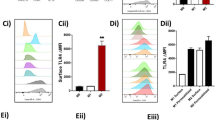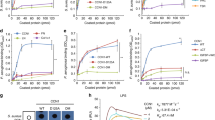Abstract
Vertebrates and invertebrates initiate a series of defence mechanisms following infection by Gram-negative bacteria by sensing the presence of lipopolysaccharide (LPS), a major component of the cell wall of the invading pathogen1. In humans, monocytes and macrophages respond to LPS by inducing the expression of cytokines, cell-adhesion proteins, and enzymes involved in the production of small proinflammatory mediators. Under pathophysiological conditions, LPS exposure can lead to an often fatal syndrome known as septic shock2. Sensitive responses of myeloid cells to LPS require a plasma protein called LPS-binding protein and the glycosylphosphatidylinositol-anchored membrane protein CD14. However, the mechanism by which the LPS signal is transduced across the plasma membrane remains unknown3. Here we show that Toll-like receptor 2 (TLR2) is a signalling receptor that is activated by LPS in a response that depends on LPS-binding protein and is enhanced by CD14. A region in the intracellular domain of TLR2 with homology to a portion of the interleukin (IL)-1 receptor that is implicated in the activation of the IL-1–receptor-associated kinase is required for this response. Our results indicate that TLR2 is a direct mediator of signalling by LPS.
This is a preview of subscription content, access via your institution
Access options
Subscribe to this journal
Receive 51 print issues and online access
$199.00 per year
only $3.90 per issue
Buy this article
- Purchase on Springer Link
- Instant access to full article PDF
Prices may be subject to local taxes which are calculated during checkout





Similar content being viewed by others
References
Rietschel, E. T. & Brade, H. Bacterial endotoxins. Sci. Am. 267, 54–61 (1992).
Parillo, J. E. Pathogenetic mechanisms of septic shock. N. Engl. J. Med. 328, 1471–1477 (1993).
Ulevitch, R. J. & Tobias, P. S. Receptor-dependent mechanisms of cell stimulation by bacterial endotoxin. Annu. Rev. Immunol. 13, 437–457 (1995).
Belvin, M. P. & Anderson, K. V. Aconserved signaling pathway: the Drosophila toll-dorsal pathway. Annu. Rev. Cell Dev. Biol. 12, 393–416 (1996).
Lemaitre, B., Nicolas, E., Michaut, L., Reichhart, J. M. & Hoffmann, J. A. The dorsoventral regulatory gene casette spatzle/Toll/cactus controls the potent antifungal response in Drosophila adults. Cell 86, 973–983 (1996).
Gay, N. J. & Keith, F. J. Drosophila Toll and IL-1 receptor. Nature 351, 355–356 (1991).
Heguy, A., Baldari, C. T., Macchia, G., Telford, J. L. & Melli, M. Amino acids conserved in interleukin-1 receptors (IL-1Rs) and the Drosophila toll protein are essential for IL-1R signal transduction. J. Biol. Chem. 267, 2605–2609 (1992).
Dangl, J. & Holub, E. La dolce vita: a molecular feast in plant–pathogen interactions. Cell 91, 17–24 (1997).
Hammond-Kosack, K. E. & Jones, J. D. G. Plant disease resistance genes. Annu. Rev. Plant Physiol. plant Mol. Biol. 48, 575–607 (1997).
Kidd, S. Characterization of the Drosophila cactus locus and analysis of interactions between cactus and dorsal proteins. Cell 71, 623–635 (1992).
Baeuerle, P. A. & Henkel, T. Function and activation of NF-κB in the immune system. Annu. Rev. Immunol. 12, 141–179 (1994).
Medzhitov, R., Preston-Hurlburt, P. & Janeway, C. A. J Ahuman homologue of the Drosophila Toll protein signals activation of adaptive immunity. Nature 388, 394–397 (1997).
Rock, F. L., Hardiman, G., Timans, J. C., Kastelein, R. A. & Bazan, J. F. Afamily of human receptors structurally related to Drosophila Toll. Proc. Natl Acad. Sci. USA 95, 588–593 (1998).
Matsuura, K. et al. Upregulation of mouse CD14 expression in Kupffer cells by lipopolysaccharide. J. Exp. Med. 179, 1671–1676 (1994).
Marchant, A., Duchow, J., Delville, J. P. & Goldman, M. Lipopolysaccharide induces up-regulation of CD14 molecule on monocytes in human whole blood. Eur. J. Immunol. 22, 1663–1665 (1992).
Croston, G. E., Cao, Z. & Goeddel, D. V. NF-κB activation by interleukin-1 (IL-1) requires an IL-1 receptor-associated protein kinase activity. J. Biol. Chem. 270, 16514–16517 (1995).
Delude, R. L. et al. CD14-mediated translocation of nuclear factor-κB induced by lipopolysaccharide does not require tyrosine kinase activity. J. Biol. Chem. 269, 22253–22260 (1994).
Lee, J. D. et al. Glycosyl-phosphatidylinositol-anchored or integral membrane forms of CD14 mediate identical cellular responses to endotoxin. Proc. Natl Acad Sci. USA 90, 9930–9934 (1993).
Bazil, V. et al. Biochemical characterization of a soluble form of the 53-kDa monocyte surface antigen. Eur. J. Immunol. 16, 1583–1589 (1986).
Frey, E. A. et al. Soluble CD14 participates in the response of cells to lipopolysaccharide. J. Exp. Med. 176, 1665–1671 (1992).
Medzhitov, R. & Janeway, C. A. J Self-defense: the fruit fly style. Proc. Natl Acad. Sci. USA 95, 429–430 (1998).
Lemaitre, B., Reichhart, J. M. & Hoffmann, J. A. Drosophila host defense: differential induction of antimicrobial peptide genes after infection by various classes of microorganisms. Proc. Natl Acad. Sci. USA 94, 14614–14619 (1997).
Lemaitre, B. et al. Functional analysis and regulation of nuclear import of dorsal during the immune response in Drosophila. EMBO J. 14, 536–545 (1995).
Medzhitov, R. & Janeway, C. A. J Innate immunity: the virtues of a nonclonal system of recognition. Cell 91, 295–298 (1997).
Mark, M. R. et al. rse, a novel receptor-type tyrosine kinase with homology ot Axl/Ufo, is expressed at high levels in the brain. J. Biol. Chem. 269, 10720–10728 (1994).
Luoh, S. M. et al. Cloning and characterization of a human leptin receptor using a biologically active leptin immunoadhesin. J. Mol. Endocrinol. 18, 77–85 (1997).
Acknowledgements
We thank our colleagues at Genentech, in particular members of the SPDI team, for helpful and invigorating discussions, and the oligonucleotide synthesis group for the preparation of synthetic DNA.
Author information
Authors and Affiliations
Corresponding author
Rights and permissions
About this article
Cite this article
Yang, RB., Mark, M., Gray, A. et al. Toll-like receptor-2 mediates lipopolysaccharide-induced cellular signalling. Nature 395, 284–288 (1998). https://doi.org/10.1038/26239
Received:
Accepted:
Issue Date:
DOI: https://doi.org/10.1038/26239
This article is cited by
-
Carvacrol attenuated lipopolysaccharide-induced intestinal injury by down-regulating TLRs gene expression and regulating the gut microbiota in rabbit
Scientific Reports (2023)
-
Morphogenic plasticity: the pathogenic attribute of Candida albicans
Current Genetics (2023)
-
Evidence of a role for interleukin-6 in anoikis resistance in oral squamous cell carcinoma
Medical Oncology (2022)
-
A review of health effects associated with exposure to jet engine emissions in and around airports
Environmental Health (2021)
-
Effects of elevated CO2 levels on lung immune response to organic dust and lipopolysaccharide
Respiratory Research (2021)
Comments
By submitting a comment you agree to abide by our Terms and Community Guidelines. If you find something abusive or that does not comply with our terms or guidelines please flag it as inappropriate.



